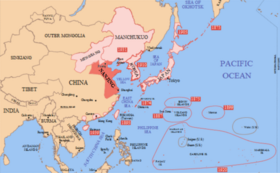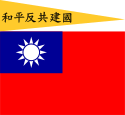Governo nacionalista de Nanquim
| 中華民國 Zhōnghuá Mínguó República da China | |||||
| |||||
| |||||
 Em rosa, os demais territórios chineses ocupados pelo Japão. | |||||
| Continente | Ásia | ||||
| País | China | ||||
| Capital | Nanking | ||||
| Governo | Estado satélite unipartidário Colaboracionista | ||||
| Presidente | |||||
| • 1940–1944 | Wang Jingwei | ||||
| • 1944–1945 | Chen Gongbo | ||||
| Período histórico | II Guerra Mundial | ||||
| • 30 de Março de 1940 | Fundação | ||||
| • 10 de Agosto de 1945 | Dissolução | ||||
O Governo de Wang Jingwei foi um governo fantoche do Império Japonês na República da China, criado em Março de 1940, sob a liderança de Wang Jingwei. O regime chamou-se oficialmente de República da China (中华民国, Zhonghua Mingú); outro nome oficial usado pelo regime foi Governo Nacional Reorganizado da China[1] Também é chamado às vezes de Governo nacionalista de Nanquim (em chinês: 南京 国民 政府, pinyin: Nánjīng Guó Mín Zhèngfǔ), ou República da China - Nanquim. Outros nomes são "Regime de Wang Jingwei" (汪精卫 政权, Zhèngquán Wang Jingwei), ou simplesmente regime de Nanquim.
Ínicio
[editar | editar código-fonte]O governo de Wang Jingwei foi um dos vários "estados fantoches" dos japoneses durante a Segunda Guerra Sino-Japonesa (1937-1945), e foi criado para rivalizar com o governo legítimo do Generalíssimo Chiang Kai-shek (Wade-Giles: Chiang Kai-shek), que estava com o mesmo nome (Governo Nacional da República da China) em Chongqing. Wang Jingwei era um membro da ala esquerda do Kuomintang (Wade-Giles: KMT) (KMT), que rompeu com o governo de Chiang em março de 1940 que havia rejeitado os invasores japoneses, fundando em 1939 o seu própio Kuomintang (sob liderança de Wang Jingwei) e passou a liderar de fato o Governo Reorganizado.[2]
Alegando ser o governo legítimo da República da China, utilizou a mesma bandeira e incluiu o mesmo emblema do governo nacional de Chiang Kai-shek. No entanto, foi amplamente considerado como um estado fantoche e não desfrutou de um reconhecimento diplomático, com exceção dos estados do Pacto Anti-Comintern.
O governo nacionalista de Nanquim, em teoria, foi a reintegração de várias entidades que o Japão tinha estabelecido na China setentrional e central, incluindo o Governo Reformado da República da China à leste, o Governo Provisório da República da China no Norte, e o Governo de Mengjiang na Mongólia Interior. No entanto, tanto o norte da China e a Mongólia Interior mantiveram-se relativamente livre de sua influência.
Oficialmente, o Estado foi fundado em 30 de Março de 1940 e Wang Jingwei tornou-se chefe de Estado com o apoio japonês. Ele declarou guerra aos aliados em 9 de janeiro de 1943.
Dissolução
[editar | editar código-fonte]Após a morte de Wang Jingwei em 1944, Chen Gongbo assumiu a presidencia e o legislativo após a uma reunião de emergência do Comitê Central, ficando no poder até 1945 quando declarou a dissolução do partido, seguindo a rendição do japão.[3]
Referências
- ↑ Narangoa, Li; Cribb, R.B. (2003). Imperial Japan and national identities in Asia, 1895-1945. [S.l.]: Routledge. p. 13. ISBN 0700714820
- ↑ Chen, Dawei (2010). Wang Jingwei da zhuan =: Wangjingwei da zhuan Di 1 ban ed. Beijing Shi: Hua wen chu ban she. OCLC 649681023
- ↑ Taylor, Jeremy E. (janeiro de 2019). «FROM TRAITOR TO MARTYR: DRAWING LESSONS FROM THE DEATH AND BURIAL OF WANG JINGWEI, 1944». Journal of Chinese History (em inglês) (1): 137–158. ISSN 2059-1632. doi:10.1017/jch.2017.43. Consultado em 10 de maio de 2024
Bibliografia
[editar | editar código-fonte]- David P. Barrett and Larry N. Shyu, eds.; Chinese Collaboration with Japan, 1932-1945: The Limits of Accommodation Stanford University Press 2001
- John H. Boyle, China and Japan at War, 1937–1945: The Politics of Collaboration (Harvard University Press, 1972).
- James C. Hsiung and Steven I. Levine, eds., China's Bitter Victory: The War with Japan, 1937–1945 (Armonk, N.Y.: M. E. Sharpe, 1992)
- Ch'i Hsi-sheng, Nationalist China at War: Military Defeats and Political Collapse, 1937–1945 (Ann Arbor: University of Michigan Press, 1982).
- Frederick W. Mote, Japanese-Sponsored Governments in China, 1937–1945 (Stanford University Press, 1954).
- Joseph Newman, Goodbye Japan (references about Chinese Reformed Regime) published in New York,March 1942
- Edward Behr, The Last Emperor, published by Recorded Picture Co. (Productions) Ltd and Screenframe Ltd., 1987
- Agnes Smedley, Battle Hymn of China"
- Chiang Kai Shek, The Soviet Russia in China
- Wego W. K. Chiang, How the Generalissimo Chiang Kai Shek gained the Chinese- Japanese eight years war, 1937-1945
- Alphonse Max, Southeast Asia Destiny and Realities, published by Institute of International Studies, 1985.
- Jowett, Phillip S., Rays of The Rising Sun, Armed Forces of Japan’s Asian Allies 1931-45, Volume I: China & Manchuria, 2004. Helion & Co. Ltd., 26 Willow Rd., Solihul, West Midlands, England.
Ver também
[editar | editar código-fonte]Text is available under the CC BY-SA 4.0 license; additional terms may apply.
Images, videos and audio are available under their respective licenses.


